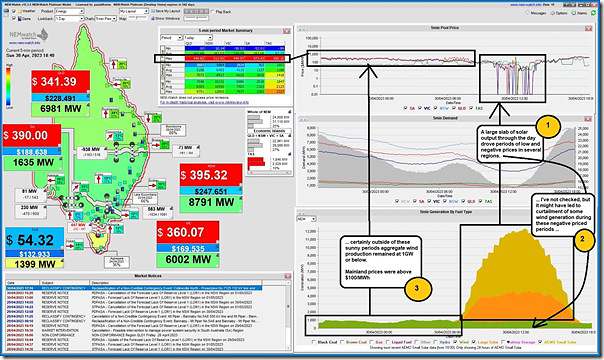In the past week we’ve seen the last three units at Liddell close:
- LD04 was second unit to close, on Monday 24th April (remembering LD03 was closed over a year ago).
- LD02 was third unit to close, on Wednesday 26th April.
- LD01 was last unit to close, on Friday 28th April (to a bit of fanfare as well).
This weekend we’ve been reminded of the challenges inherent in charting a course through this energy transition – here’s an annotated image from NEMwatch at the 18:40 dispatch interval on Sunday 30th April:
As per the annotations:
1) There was a large contribution from solar (both rooftop PV and Large-Scale Solar) through daylight hours, which drove prices negative in a number of regions for a period of time;
2) During these negatively prices periods, it’s a pretty fair bet that some wind farms were dispatched down as a result of bidding at or above their ‘negative LGC’ price band;
3) Outside of these negatively priced periods we see the aggregate production from wind was still at or below 1,000MW (dropped to a low of 594MW aggregate InitialMW metered at 18:55, as I type this) … one reason why prices in the mainland were well above $100/MWh through the night.
4) Note that network constraints may well have been a factor in curtailing production from some wind farms through the past 24 hours:
(a) Either (or both) sunlight periods and darkness periods
(b) I’ve not checked.
That’s all for now…



That is a rather bland reference to a period where the NEM would have gone black in the absence of remaining coal burners with the wind practically absent from Friday evening through the weekend into today.
At sunrise on Saturday morning the wind was delivering 6% of demand at CP 11%, in the mid afternoon the wind was delivering 4% of demand and RE was 33%, at sunset the wind delivered 3% at CP 8%, Sunday morning it was 5% at CP 10%, Sunday evening 3% at 6%CP, sunrise this morning, 3% at CP 6%.
It all over Red Rover! RE can displace coal, but not replace it.
https://www.flickerpower.com/index.php/search/categories/renewables/21-7-intermittent-solar-and-wind-power-can-displace-coal-but-cannot-replace-it
The rate of exit from coal is not accelerated by increasing penetration on good days, it is limited by the lowest level of output on nights with little or no wind, as a convoy travels at the speed of the slowest vessel, the water penetrates the levee at the lowest point, a chain is only as strong as the weakest link and stock get out of the yard through gaps even if the rest of the fence is built to the sky.
As long as periods with effectively zero solar and wind power persist, 100% backup from conventional power will still be required, assuming that we want security of supply. This means that we will have to keep burning coal until nuclear power is on deck.
Four pieces from The Spectator.
A simple demonstration that wind power will not work in Australia due to the need for continuous input to the grid, the interruption of wind power by wind droughts, and the lack of storage at the scale required to bridge the gaps.
https://www.spectator.com.au/2023/02/the-iron-triangle-of-energy-realism/
On wind droughts and lack of storage in Australia. When the next coal power station closes, every wind drought will threaten the power supply and prolonged wind droughts will be potentially catastrophic.
https://spectator.com.au/2022/07/energy-policy-where-parallel-universes-are-set-to-collide/
The vital importance of “wind literacy.” Wind droughts have been recognized in Australia for a long time but defective advice (neglecting the droughts) resulted in the the worst policy blunder in our history. This is connecting subsidised and mandated intermittent wind and solar power to the grid.
https://www.spectator.com.au/2022/11/the-voice-of-energy-realism/
How did the meteorologists hide the wind droughts?
https://www.spectator.com.au/2023/04/the-endless-wind-drought-crippling-renewables/?
Rafe your comments are valid. Looking at the AEMO dashboard it appeared NSW compensated for the wind drought by using extra hydro on the evening 30/4. But this can’t go on forever given we are at the end of La Nina.